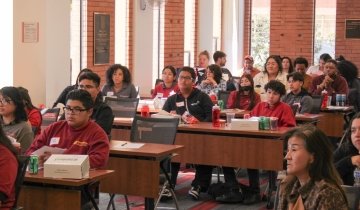The dawn of the 21st century marked the beginning of a technological era that is permanently reshaping our global society. The internet and the advent and growth of social media are changing the way we communicate, work and play; in other words, how we live. The digital divide, while still extant, is inexorably closing as broadband service and mobile devices are becoming necessities rather than luxury items reserved for only those who can afford them.
And this is only the beginning of the technological disruption that we are experiencing. Genetics, nanotechnology and robotics (GNR) offer promises and perils that we have yet to see on a grand scale, and we must prepare for their eventuality. Climate change, alternative energy resources, improved healthcare and cyberterrorism are only a few of the “Grand Challenges” facing society, and we have made too little progress in science, technology, engineering and mathematics—the STEM disciplines—to envision successful solutions for any of them in the near future.
For many years, I have felt that the United States would be unable to maintain its competitive edge in the STEM disciplines, let alone its leadership position, so long as women and underrepresented minorities face barriers to their equitable representation and participation in those fields. The shortfall of STEM college graduates, relative to that of other countries, is another indication of the penalty the U.S. is paying for its inequitable practices and policies.
I am particularly concerned about the fact that minority STEM students who attend predominantly white institutions (PWIs) are still too often confronted by individual, institutional and structural acts of racism. These students experience a sense of only-ness in classrooms, exclusion as they attempt to join study groups and micro-aggressions of various and sundry types. My primary concern is that these students almost never see a person who looks like them or shares their background as the professor in their class or laboratory. The paucity of minority faculty in PWIs, especially in engineering, is higher education’s shame. As of 2013, only 2.5 percent of engineering faculty nationwide were African Americans, 3.7 percent were Latinos/as and approximately 0.2 percent were American Indians/Alaska Natives. When you consider that these three groups constitute, 13, 17 and 0.7 percent, respectively, of the nation’s population, it is clear that the underrepresentation is an indication that systemic discrimination continues to be present in academe.
It is my belief that our nation’s educational systems—elementary, secondary and postsecondary—are failing large numbers of students, especially underrepresented minority students. Educational institutions must become more learner-centered and take more responsibility for the failure of students to achieve academic success. Rather than having a deficit-mindset when it comes to the education of first-generation, economically disadvantaged or minority students, academic institutions must become equity-minded and undertake an honest assessment of their policies and practices with respect to the support and affirmation they provide for the students who come to them for education.
I believe this to be the challenge for education going forward, and it especially applies to STEM educators in our colleges and universities. Our nation cannot and will not achieve and maintain a competitive position in the STEM disciplines until we provide a full opportunity for all persons to participate and contribute to our national capability in science and technology.
John Brooks Slaughter is Professor of Education and Engineering at USC Rossier and USC Viterbi, and Co-Director of the Center for Engineering in Education. To learn more about his distinguished career, which includes leading two universities and heading the NSF as its first African American director, watch his video.




